HKJ
Flashaholic
[SIZE=+3]Charger Opus BT-C3100[/SIZE]
Review of V2.1 version of the charger
The charger is now delivered with version 2 software. I have made some supplemental tests with that
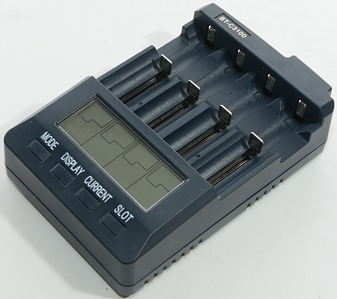
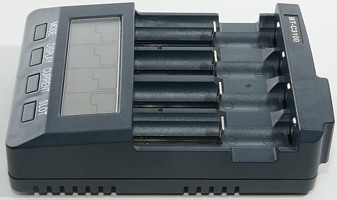
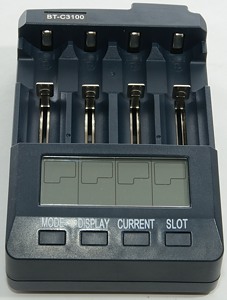
This charger is a analyzing LiIon and NiMH charger, this means the charger can both charge and discharge while measuring. The total number of function is large and this means the technical section in this review is very large.
I got the charger without any box or manual.
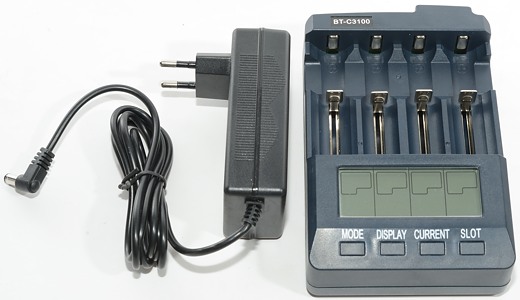
The only accessory I got was a power supply. It is a EU version, with universal voltage 100-240VAC 50/60Hz and delivers 12V 3A.
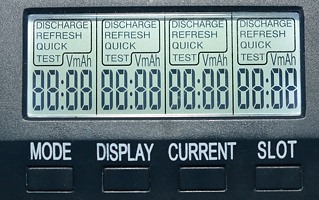
When the charger is turned on, it displays test where all the text can be seen.
When startup is finished it is possible to select mode:
When display is flashing it is possible to select mode and current.
Using the slot button it is possible to reselect a slot and change parameters for it, also when charger is working.
When putting multiple batteries in the charger at the same time, it is possible to select mode and current simultaneous for all of them (Very nice).
When charging or discharging it is possible to use the DISPLAY button to select between V, mA and mAh.
The display button can also be used when the charge/discharge is finished, but the charger will change back to "full" display rather quickly.
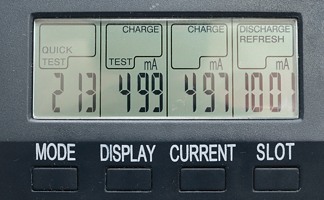
Here is an example where I have selected different functions for each slot.
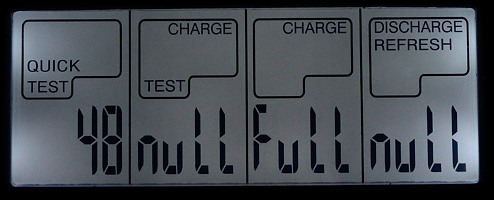
Each time a button is pressed, the light turns on for a 20 seconds.
The FULL and NULL message can also be seen.
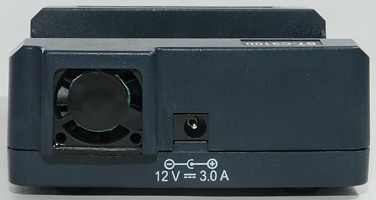
The charger uses an external 12 volt power supply at 3A (see later).
It has a fan, this is necessary to handle all four channels at full power. Even with only one channel in use the fan, it start and stop very often. The fan is not very loud, but due to the starting and stopping it is very annoying.
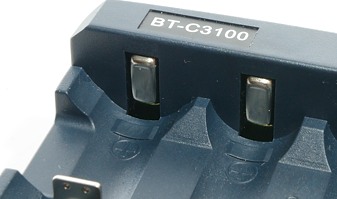
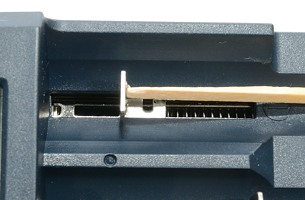
The charger uses the classical slider construction to handle most battery sizes. The slider works smoothly and can handle sizes from 32 mm to 72.5 mm.
For measuring internal resistance the slider is not very good, it often has a "high" connection resistance.
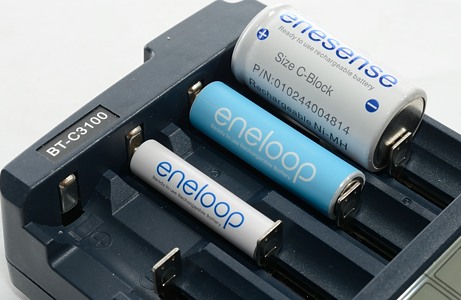
A couple of different NiMH batteries in the charger.
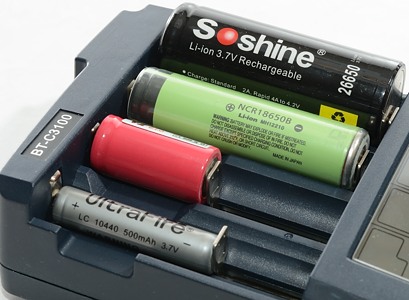
And some LiIon batteries.
Using only slot #1 and/or #4, the maximum charge current is 2000mA.
In all other cases the maximum charge current is 1000mA.
The maximum discharge current is always 1000mA.
Charge currents: 200, 300, 500, 700, 1000, 1500, 2000
Discharge currents: 200, 300, 500, 700, 1000

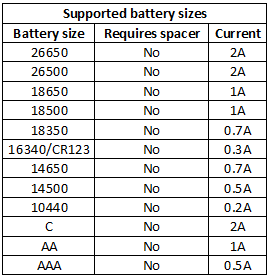
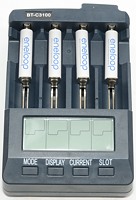
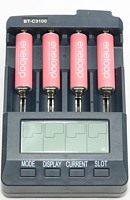

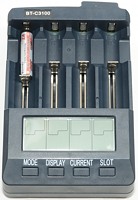
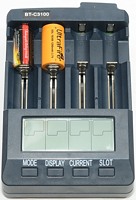
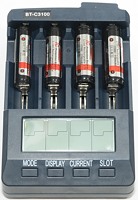
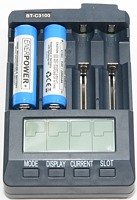
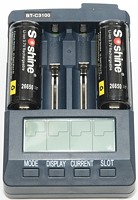
The charger can easily handle 70 mm long batteries including flat top cells.
It is recommended to charge smaller batteries in the two center slots.
The charger has an internal switch marked with 3.7V, 4.20V and 4.35V. I have not tested this switch, because it is internal, but it might be possible to charge other LiIon chemistries.
[SIZE=+2]Measurements[/SIZE]
[SIZE=+3]CHARGE LiIon batteries[/SIZE]
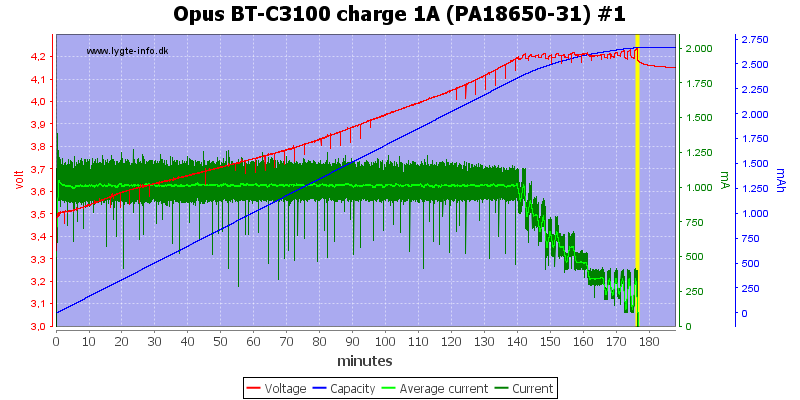
Charging a 18650 cell at 1A, look at the curves just before the yellow line. The charger is oscillating and it stops charging a bit premature.
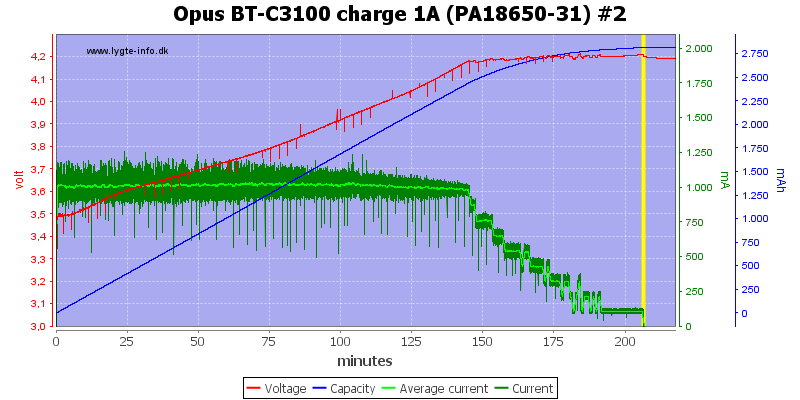
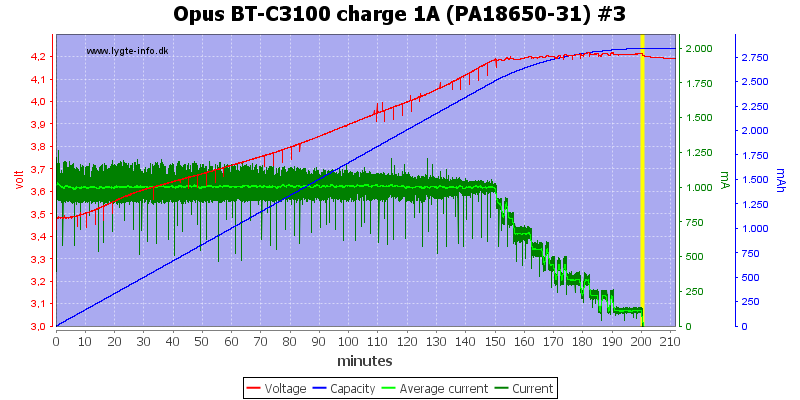
The second and third channel works perfectly.
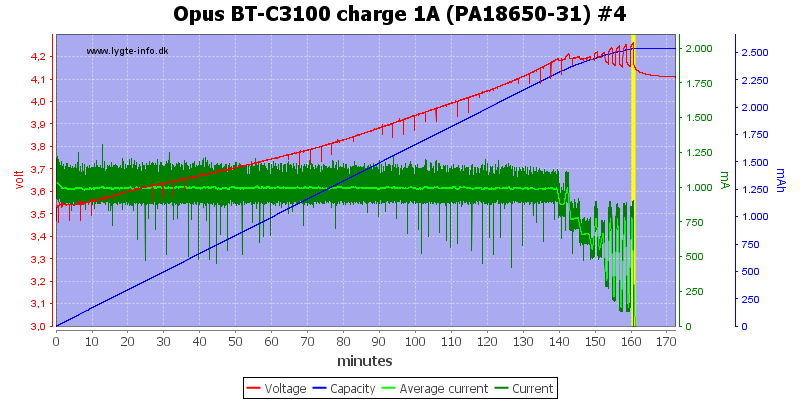
Here the oscillation is even worse and the charger again stops premature.
According to the display I charged 2543mAh into the battery.
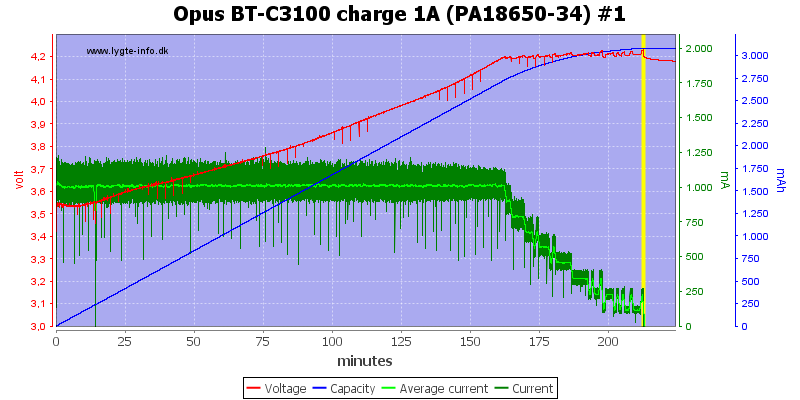
A 3400mAh cell did also have some oscillations, but not enough to affect the charge.
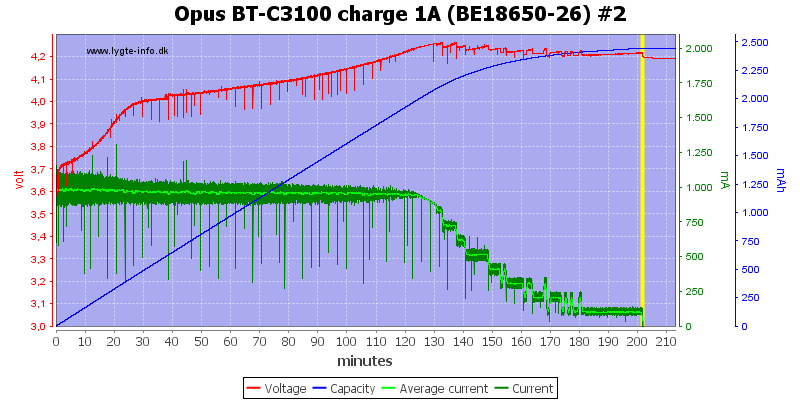
The 2600mAh battery in slot #2 worked better, but the charger was a bit slow in changing from CC to CV phase (This is within allowable tolerances).
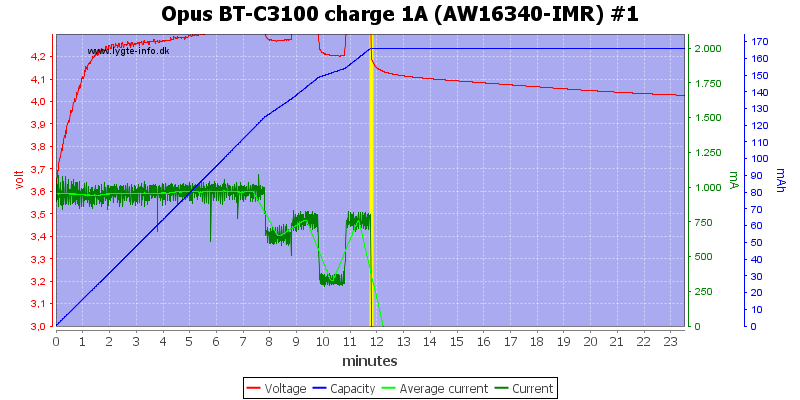
What happens with a old very soft (High Ri) battery? The charger can definitely not handle this at least not in slot #1.
Here it is also very easy to see that the oscillations are based on the 1 minute voltage measurement rate.
My guess is that the oscilliation is due to "high" internal impedance in the batteries, i.e. to avoid oscillations use low charge current and the center slots, especially with small batteries and old batteries.
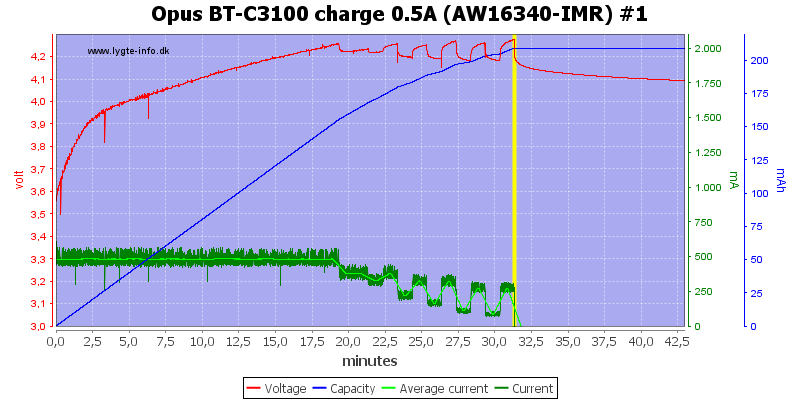
Lets reduce the charge current. This did improve the charging considerable.
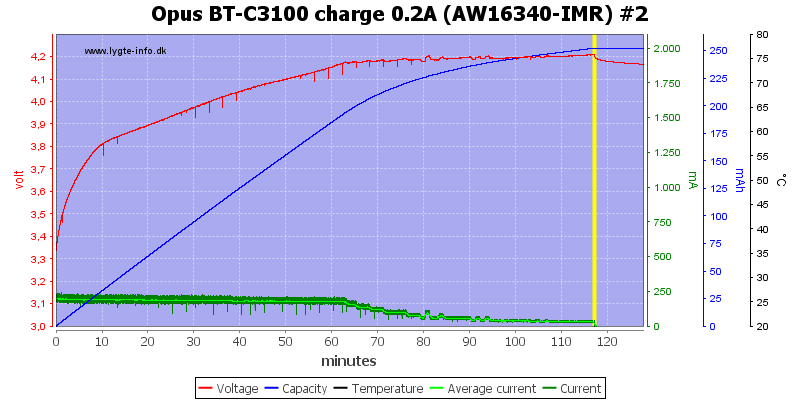
Reducing the charge current even more and using slot #2 fixed the charge curve. This is a perfect CC/CV curve.
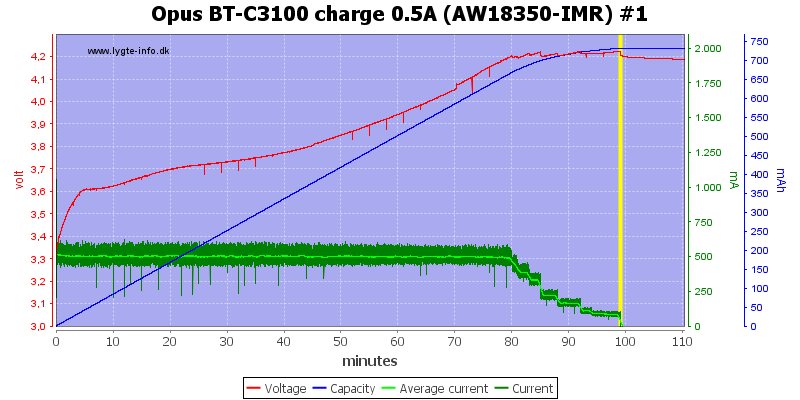
Using a newer battery in slot #1 does work fine.
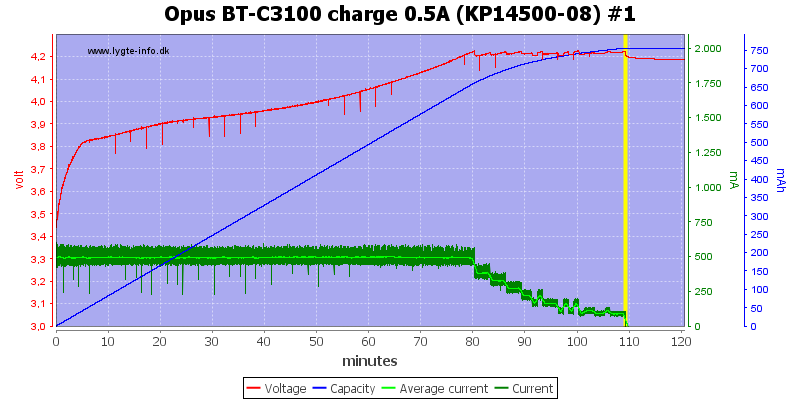
The 14500 does also charge fine.
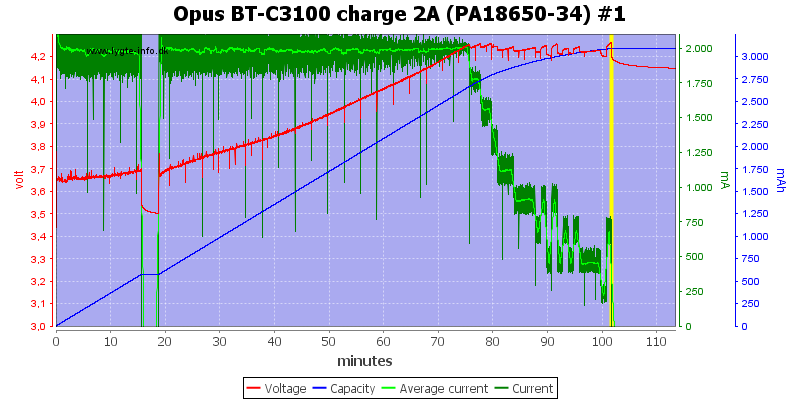
At 2A the charger needed a rest during charge and the oscillations are rather bad.
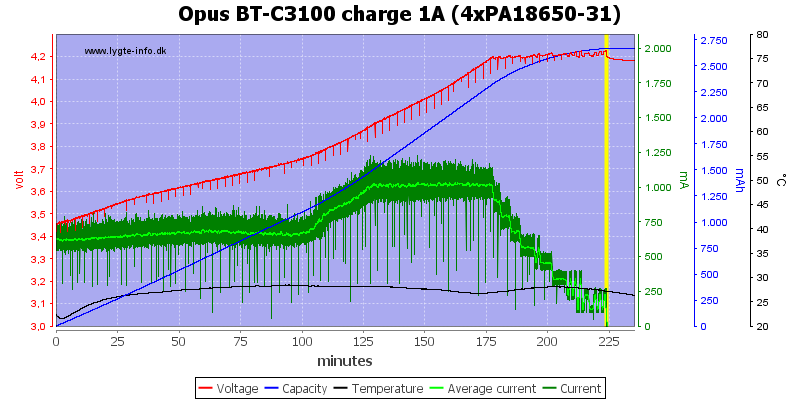
4 batteries at once at full current. This look strange the charger only charges with 700mA for the first two hours. The display did show 1000mA charge current!
According to the display I charged 3297mAh, 2895mAh, 2914mAh, 3351mAh into the batteries. Rather impressive with 3300mAh in a 3100mAh battery.
My measuring equipment was on slot #1 and it looks like the battery was nearly fully charged.
Luckily the charged mAh is not that important, the important value is for discharge.
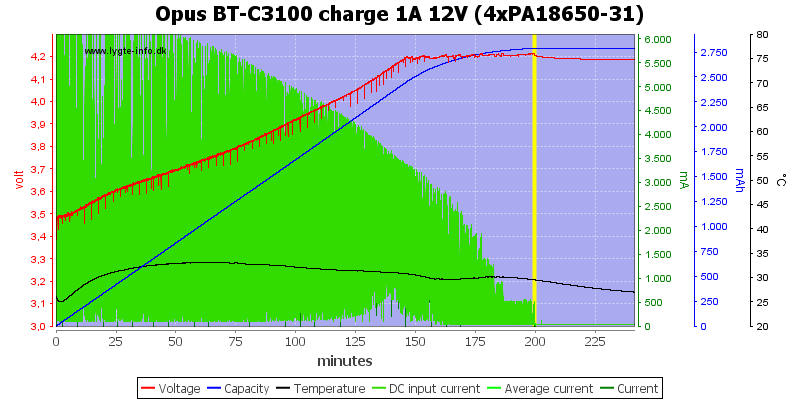
Same as above, but I am using an my own power supply, notice the green current scale. The charger is using considerable more than 3A from the power supply (That also explain the flashing led on the supplied power supply).
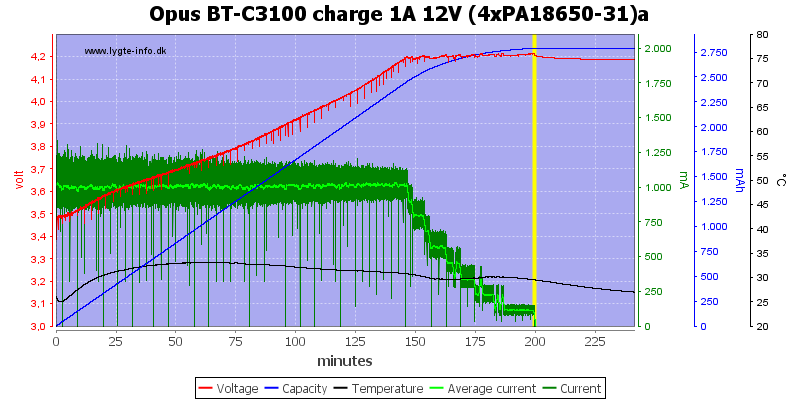
Same curve as above, but I have removed the "DC input current" from the chart. It can be seen that the charger charges perfectly with 1A.
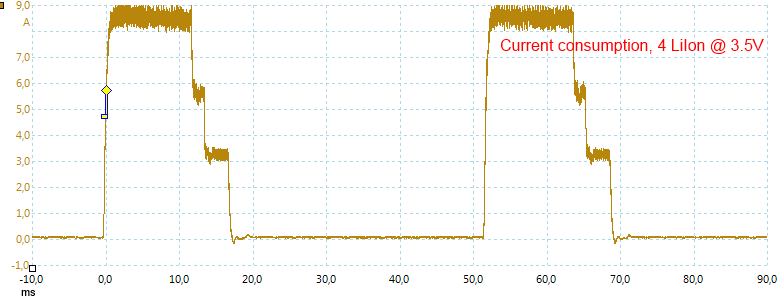
A scope trace of the input current shows what is going on. The charger draws some very high current pulses (About 9A) when it pulses the charge current. These pulses will be less when the battery voltage goes up.
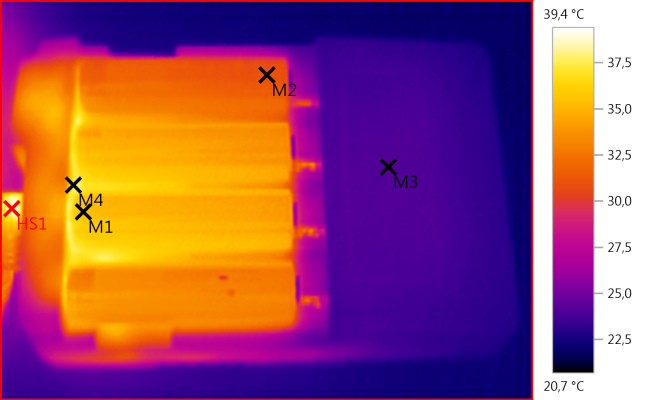
M1: 35,5°C, M2: 31,0°C, M3: 24,1°C, M4: 37,3°C, HS1: 39,4°C
The fan is helping keeping the temperature down, batteries are not that hot.
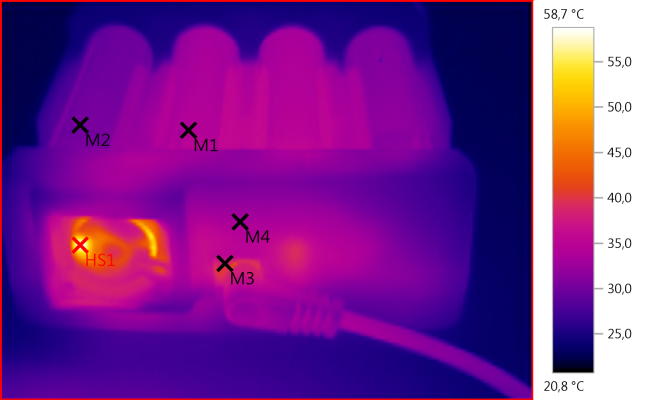
M1: 34,3°C, M2: 30,2°C, M3: 38,9°C, M4: 33,4°C, HS1: 58,7°C
But something inside the charger is getting warm.
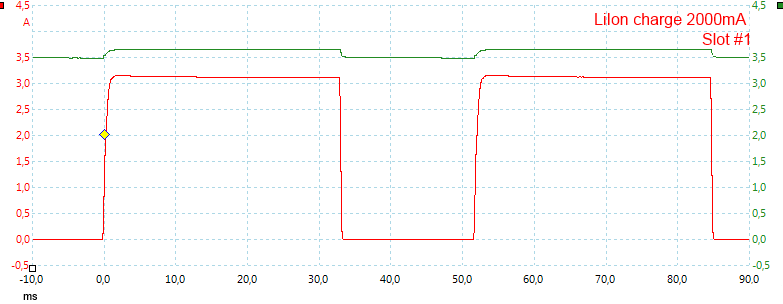
At full 2000mA charge the charge pulses are rather long and with 3A current. The current and pulse width will change with the actual battery voltage.

Minimum charge current, this current is even higher and the pulse is short.
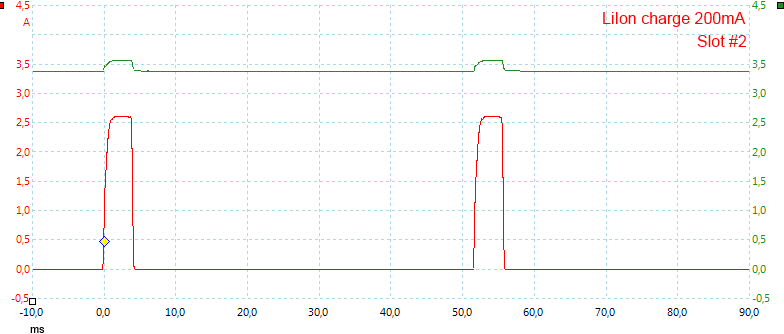
The two center slot has smaller current pulses, but works the same way.
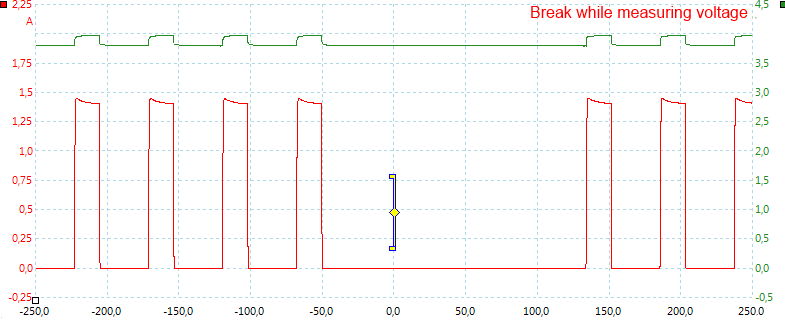
Why is there 1 minute between updating voltage, my guess was that it must be because it takes some time to measure voltage and the charger stops charging once a minute to measure. I started searching for a break in charge current and yes it is there.
Also note that the peak current is lower, because the battery has higher voltage in this chart.
[SIZE=+3]DISCHARGE LiIon batteries[/SIZE]
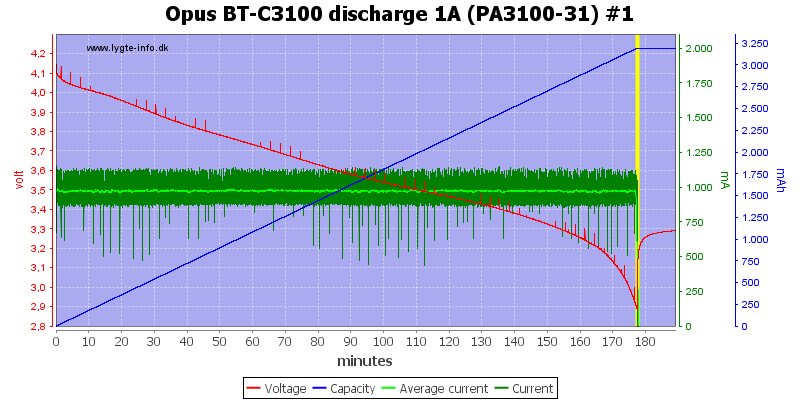
The discharge looks nice. It discharges down to 2.9 volt, it is a good value (In my test I uses 2.8 volt).
LiIon batteries are usual rated for 2.5, 2.75 or 3.0 volt discharge, the 3.0 volt type might theoretically be damaged, but I have not seen any in my test to 2.8 volt.
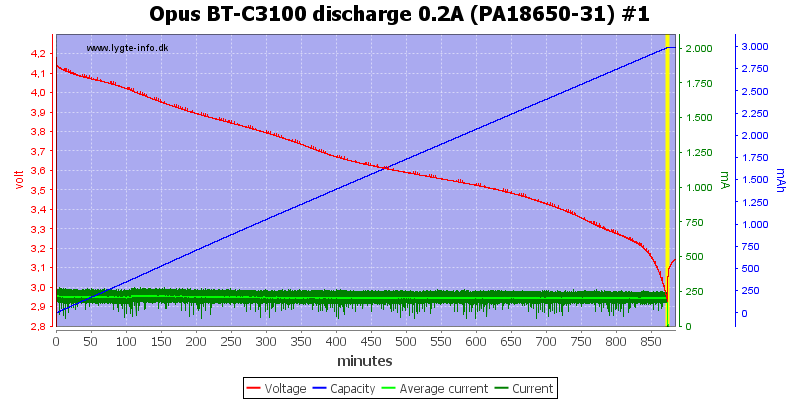
0.2A discharge also looks fine.
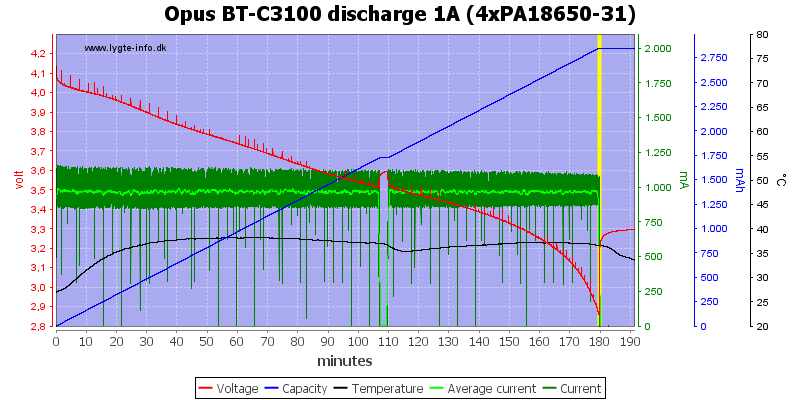
With 4 LiIon at 1A the charger needs to get rid of a lot of heat, i.e. the fan runs at full speed. This was not enough, the charger did take a break during the discharge
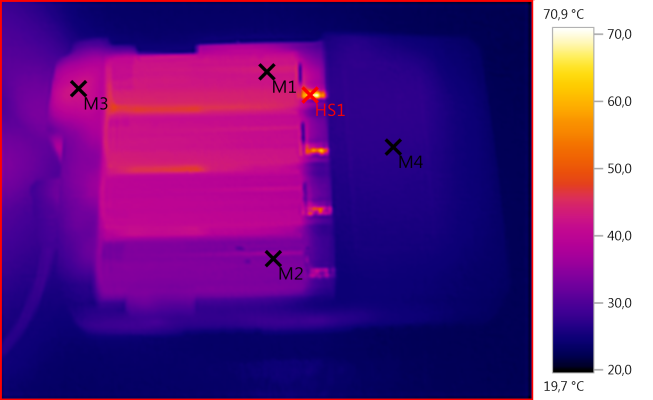
M1: 43,0°C, M2: 33,4°C, M3: 42,5°C, M4: 27,0°C, HS1: 70,9°C
The resistors for discharging is placed under the 3 of the batteries and get fairly hot, this does also warm the batteries.
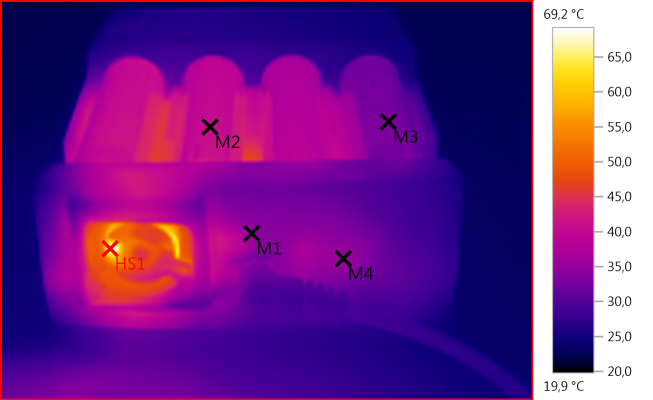
M1: 35,2°C, M2: 40,7°C, M3: 33,1°C, M4: 35,4°C, HS1: 69,2°C
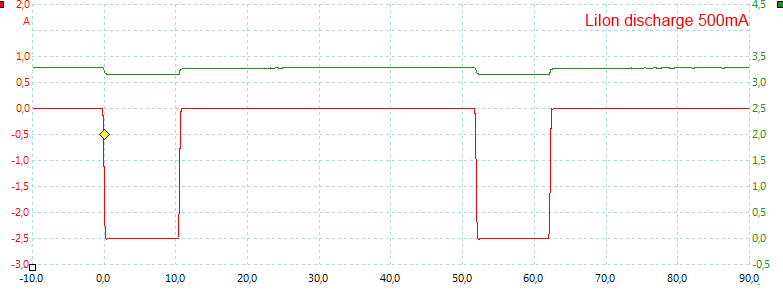
The discharge does also uses pulses, but they are the same on all channels. The high current is because the charger uses the same resistor bank for NiMH and LiIon.
[SIZE=+3]DISCHARGE REFRESH LiIon batteries, cycles batteries[/SIZE]
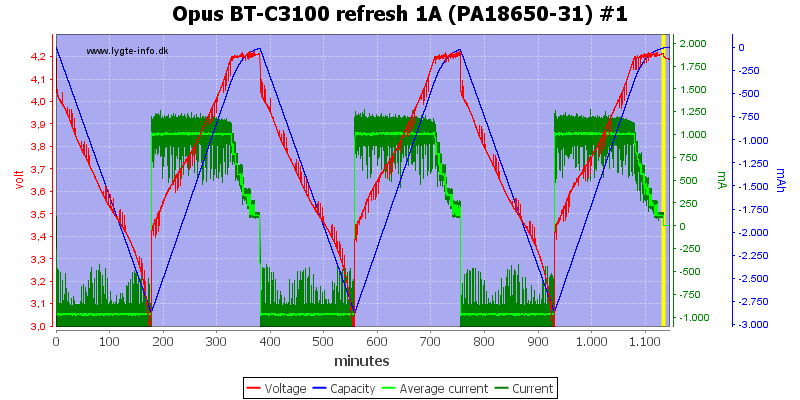
This mode will discharge and charge 3 times. This can be useful for NiMH batteries, but there is really no use for LiIon cells.
[SIZE=+3]CHARGE TEST LiIon batteries, measure capacity[/SIZE]
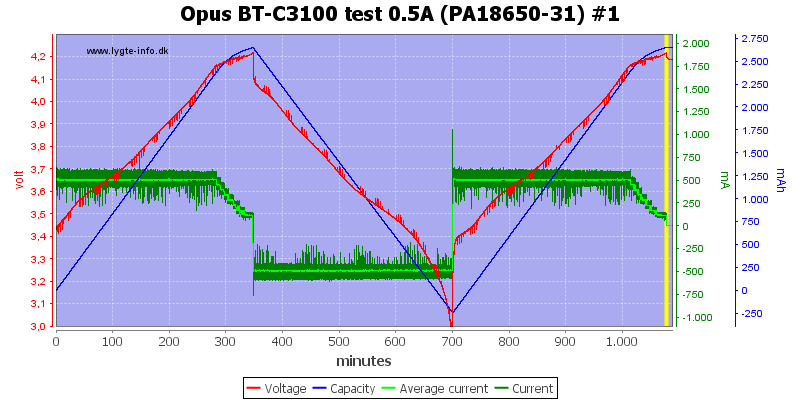
To test capacity on batteries the test mode is more useful, it will charge the battery, discharge it and charge it again.
[SIZE=+3]QUICK TEST LiIon batteries, i.e. measuring internal resistance[/SIZE]
I tried with the same LiIon cell in all slots a couple of times (I used a 18500, this made it possible to get my thumb behind the cell an increase the pressure):

There is some variation between the results, applying extra pressure did reduce the contact resistance.
My AC impedance tester measured 17 mOhm +/-1 mOhm during a couple of tries (Note AC and DC impedance is not expected to be the same).
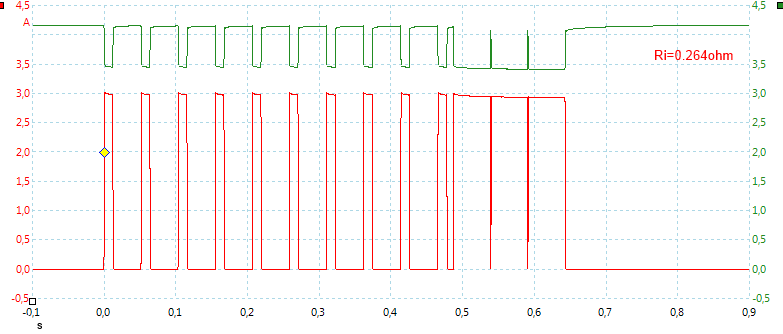
The measuring is done with a short pulse load. I uses 0.1ohm resistor in series with the battery to measure the current, tis is, of course, included in the Ri value measured by the charger.
[SIZE=+3]CHARGE NiMH batteries[/SIZE]
Note: Some of the used eneloops had low capacity.
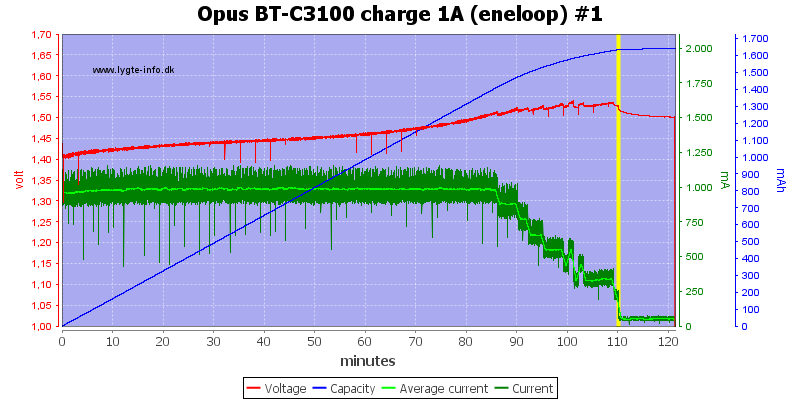
Interesting charger curve, it looks like the charger is using a CC/CV algorithm for NiMH batteries. The charger does a good job with the charging.
Also note that the charger uses trickle charging when the main charge is finished, this is not really a good idea for LSD cells.
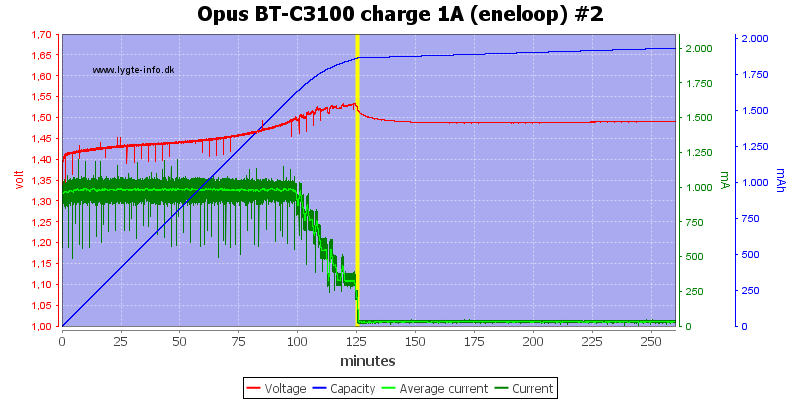
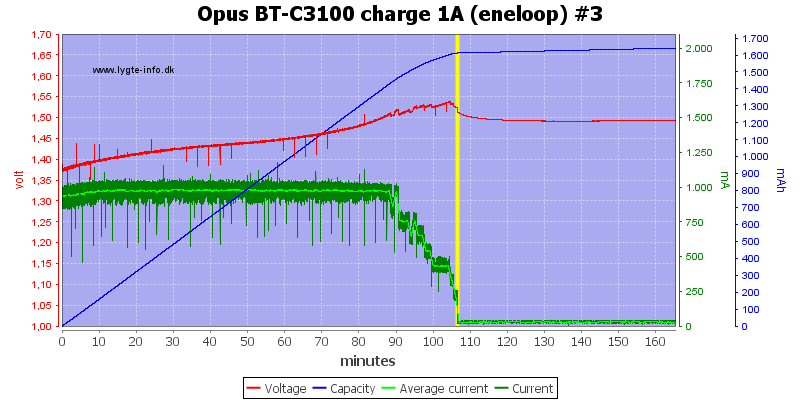
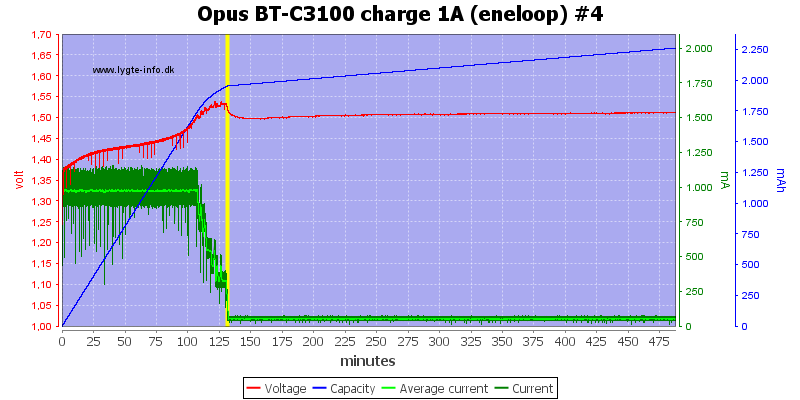
The other slots also looks good.
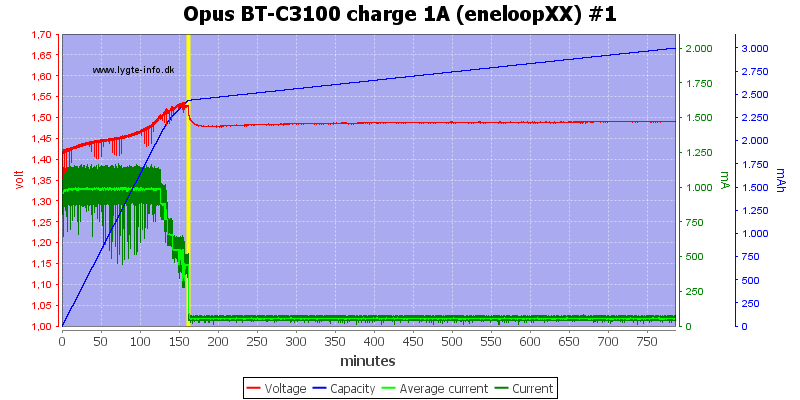
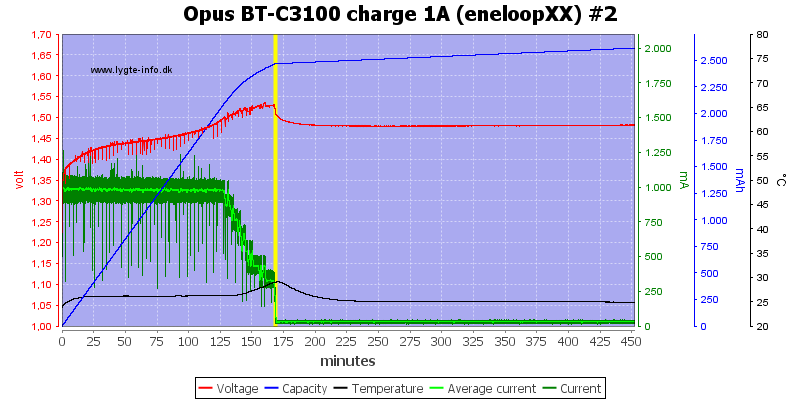
I tried the eneloop XX in both slot types and it did also work fine. Notice the temperature in the slot #2 chart, when it starts increasing the battery is full and a bit later (about 30 minutes) the charge terminates.
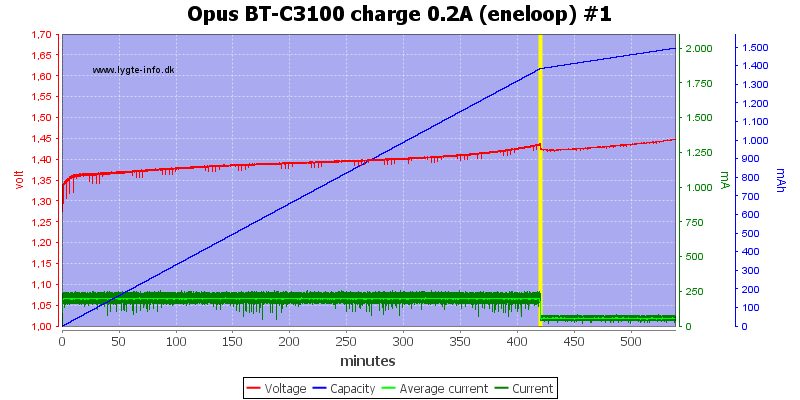
Even at a low charge current the charger terminates, but this is probably due to a 7 hour timeout in the charger and not because it detects a full cell (The display shows exactly 7:00 in time).
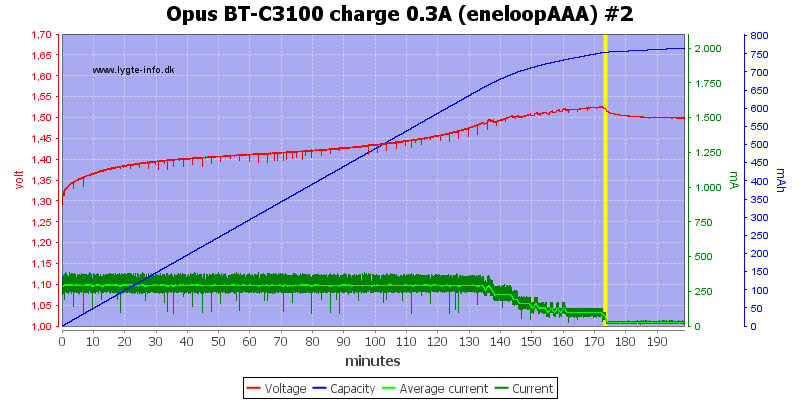
A AAA battery does also look fine.
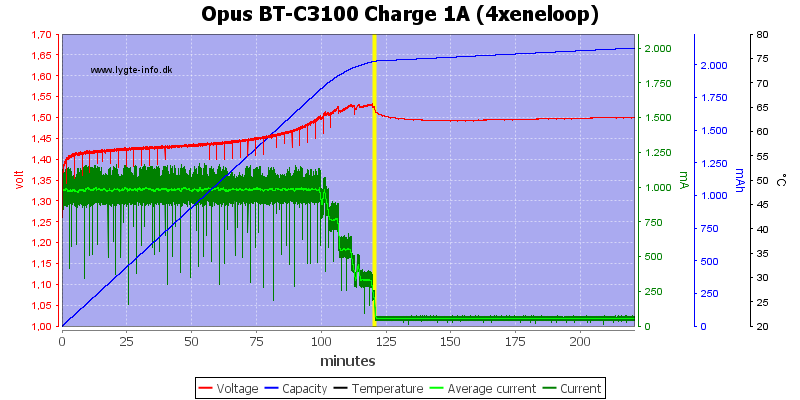
Charging 4 eneloops at the same time looks fine.
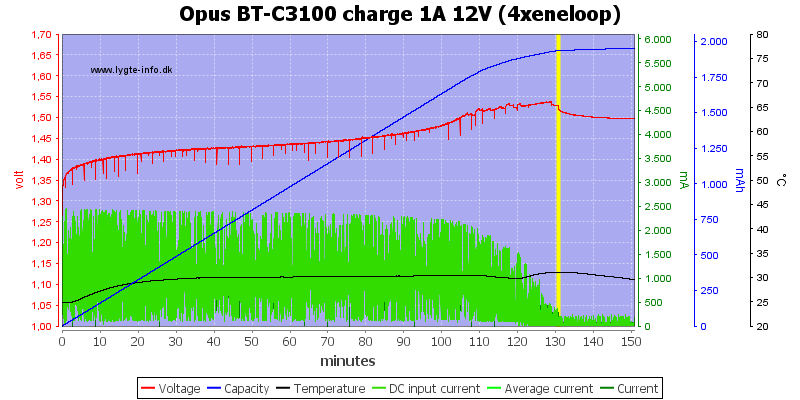
When I uses my own 12 volt power supply I do not see any high current draw.
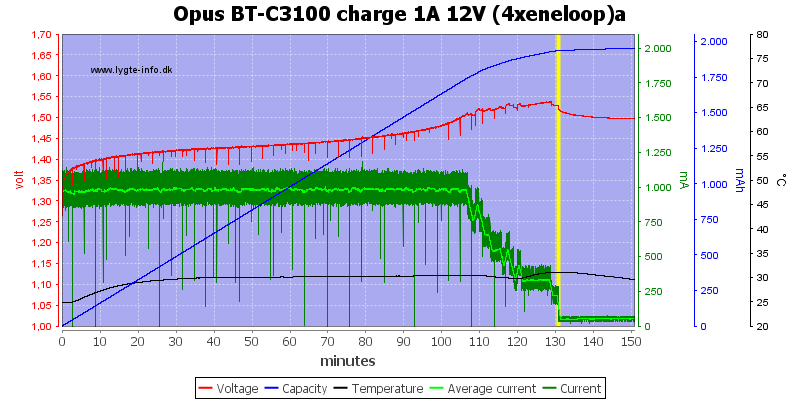
And the charge curve looks fine (Same as above, I have just removed the DC input current trace).
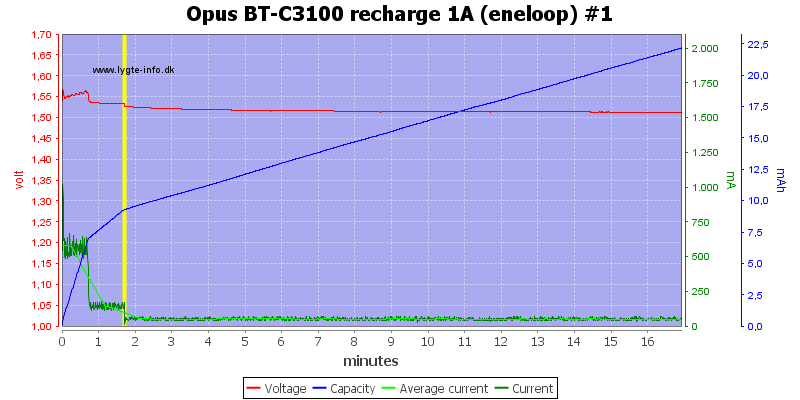
A full eneloop battery was detected within 2 minutes.
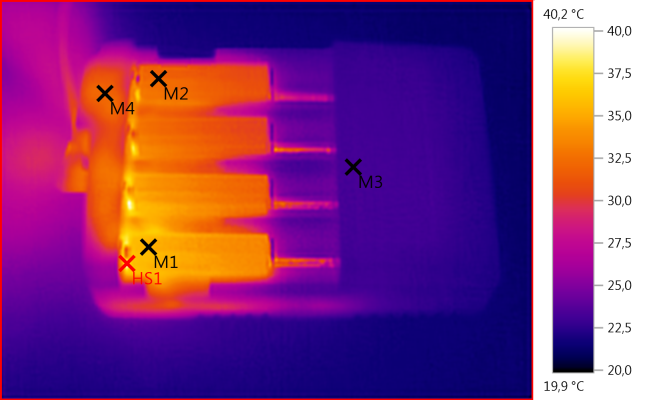
M1: 35,5°C, M2: 32,2°C, M3: 23,2°C, M4: 32,0°C, HS1: 40,2°C
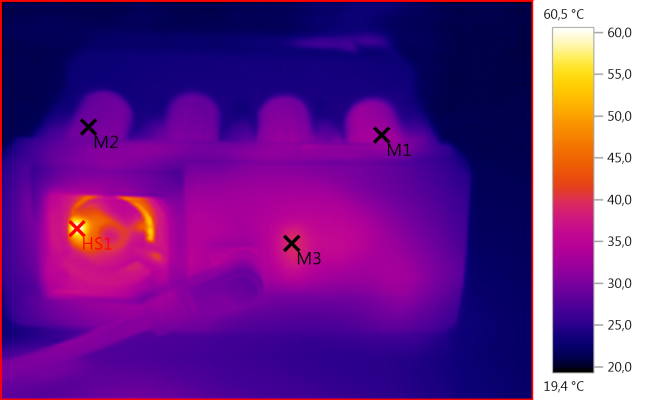
M1: 32,5°C, M2: 29,7°C, M3: 39,3°C, HS1: 60,5°C
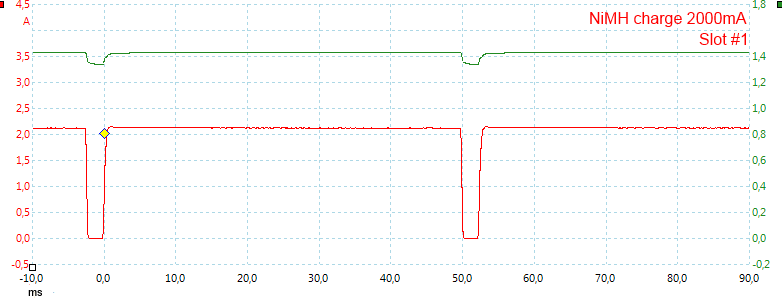
Charging is controlled with pwm for NiMH, but the maximum current is less.
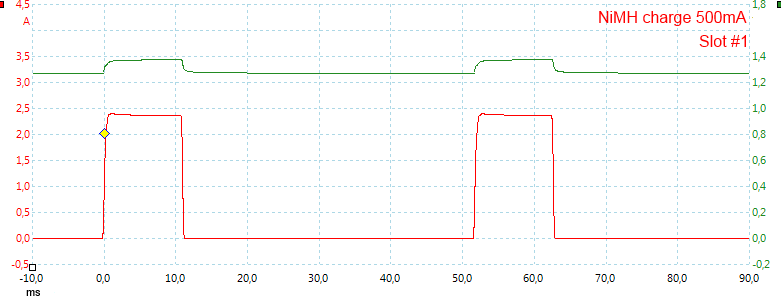
Lower charge current will adjust the pwm to shorter on time.
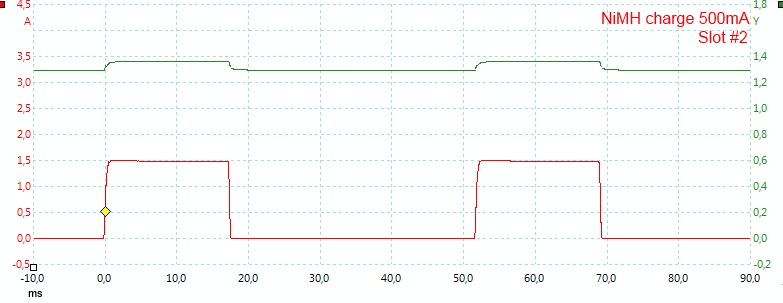
On the center slots the current is less.
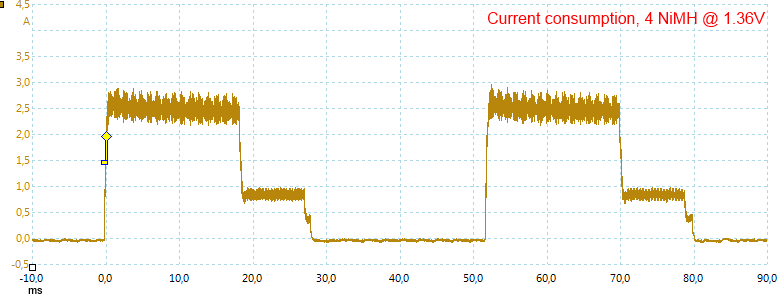
I also checked the current consumption with NiMH, it stays below 3A.
[SIZE=+3]DISCHARGE NiMH batteries[/SIZE]
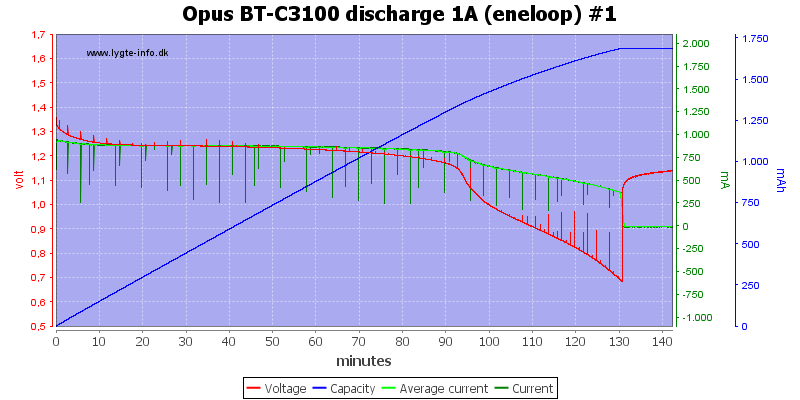
The discharge curve for NiMH is rather interesting, I had selected 1A current but the actual discharge only starts at 1A, most of the time the current is below 1A, at the end even below 0.5A. The display on the charger reflects this.
This is, of course, because the NiMH and LiIon batteries shares the same discharge resistor of about 1.3 ohm and it is not possible to get 1A from the batteries with that resistor.
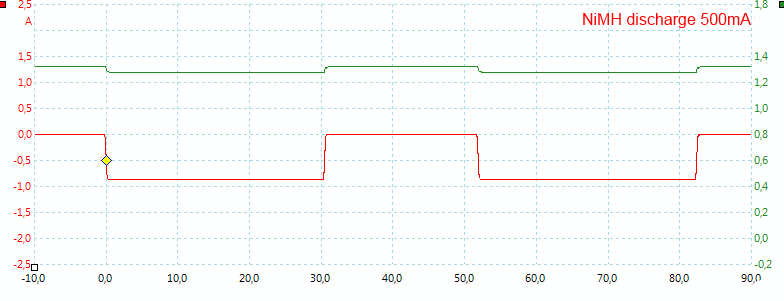
Again pwm is used.
[SIZE=+3]DISCHARGE REFRESH NiMH LiIon batteries, cycles batteries[/SIZE]
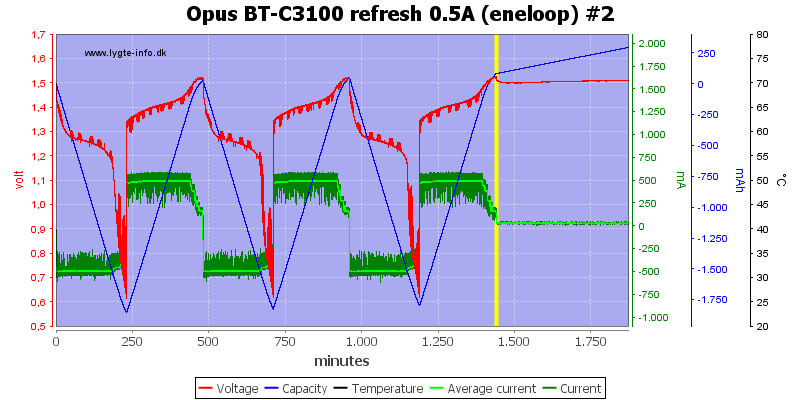
The refresh function does 3 cycles, this can be used to restore batteries that have been unused for some time.
This function takes a day when run at 0.5A on 2000mAh batteries.
[SIZE=+3]CHARGE TEST NiMH batteries, used to measure capacity[/SIZE]
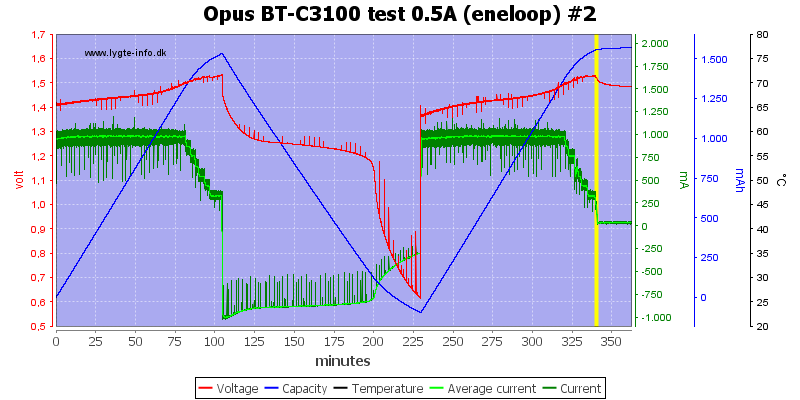
This function charger, discharges and charges again and is used to measure the capacity of cells.
[SIZE=+3]QUICK TEST NiMH batteries, i.e. measuring internal resistance[/SIZE]
I tried with the same NiMH cell in all slots a couple of times:

The result varies a lot. In the second table I added extra pressure to the slider and rotated the battery slightly to get as low contact resistance as possible. The result did improve, but there is still a lot of variance.
My AC impedance tester measured 23 mOhm +/-1 mOhm during a couple of tries (Note AC and DC impedance is not expected to be the same).
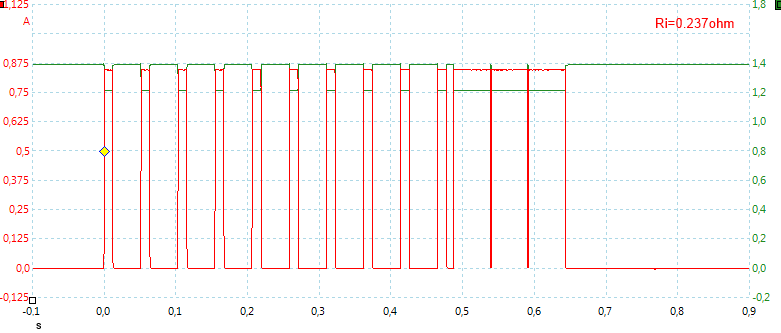
The measuring is done with a short pulse load.
[SIZE=+3]CHARGE with both NiMH and LiIon batteries[/SIZE]
With a charger that can do both eneloop and LiIon it is interesting to see if it has any problem doing them at the same time.
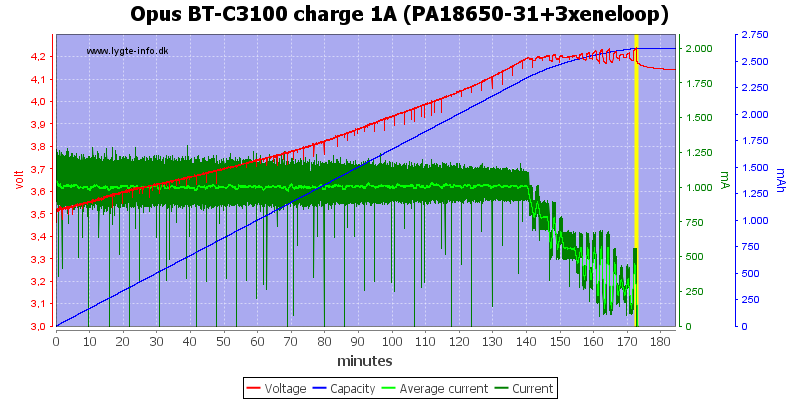
Here I am measuring on the LiIon and it looks very much like a single LiIon, i.e. the NiMH batteries does not affect it.
But the oscillations do not look good.
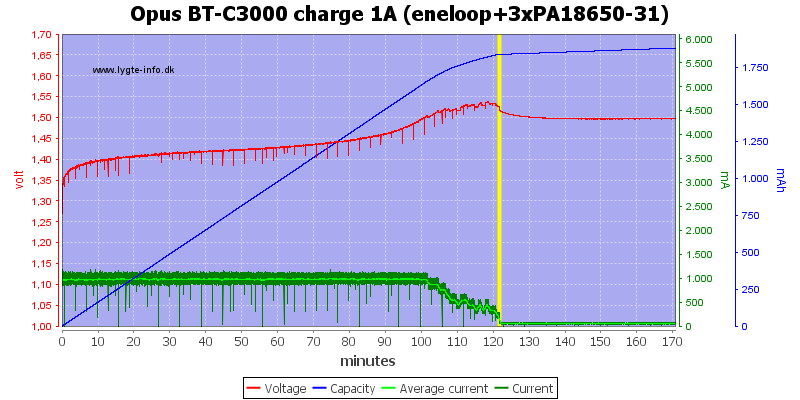
A eneloop together with 3 LiIon works fine.
Testing with 2500 volt and 5000 volt between mains and low volt side on power supply, did not show any safety problems.
[SIZE=+2]Conclusion[/SIZE]
The charger has a lot of functionality but not everything is perfect:
The user interface is fairly easy to use, but it may take a some time to learn what the different modes does.
The high current peak from the power supply is not good for the power supply and makes the charger show wrong readings.
The oscillations prevents fully charging some LiIon cells and may lead to over voltage on old cells.
Generally the peak charge and discharge current for LiIon are a bit high, especially on the outer slots.
The resistance measurement has limited use, mostly due to contact resistance.
I would have prefered constant current, instead of the pulsing.
I am a bit suspicious about the NiMH termination, in my tests it works perfectly, but will it do that will all types of batteries?
Can the charger be used?
I will definetely say yes, the discharge test works fine and charging LiIon in the center slots does also work fine.
NiMH works perfectly in all slots and all modes.
[SIZE=+2]Notes[/SIZE]
When measuring charge current with an oscilloscope I has a 0.1 ohm resistor in series with the battery, this means that the measured currents is a lower than reality.
The charger was supplied by kreisl for review.
Here is an explanation on how I did the above charge curves: How do I test a charger
Review of V2.1 version of the charger
The charger is now delivered with version 2 software. I have made some supplemental tests with that



This charger is a analyzing LiIon and NiMH charger, this means the charger can both charge and discharge while measuring. The total number of function is large and this means the technical section in this review is very large.
I got the charger without any box or manual.

The only accessory I got was a power supply. It is a EU version, with universal voltage 100-240VAC 50/60Hz and delivers 12V 3A.

When the charger is turned on, it displays test where all the text can be seen.
When startup is finished it is possible to select mode:
- CHARGE: Charge battery with 200 to 1000 (2000) mAh.
- DISCHARGE: Discharge battery with 200 to 1000 mAh.
- DISCHARGE REFRESH: Discharge and charge the battery 3 times.
- CHARGE TEST: Charge, discharge and charge the battery, show how much current was discharged.
- QUICK TEST: Measure the internal resistance of the battery.
When display is flashing it is possible to select mode and current.
Using the slot button it is possible to reselect a slot and change parameters for it, also when charger is working.
When putting multiple batteries in the charger at the same time, it is possible to select mode and current simultaneous for all of them (Very nice).
When charging or discharging it is possible to use the DISPLAY button to select between V, mA and mAh.
The display button can also be used when the charge/discharge is finished, but the charger will change back to "full" display rather quickly.

Here is an example where I have selected different functions for each slot.

Each time a button is pressed, the light turns on for a 20 seconds.
The FULL and NULL message can also be seen.

The charger uses an external 12 volt power supply at 3A (see later).
It has a fan, this is necessary to handle all four channels at full power. Even with only one channel in use the fan, it start and stop very often. The fan is not very loud, but due to the starting and stopping it is very annoying.


The charger uses the classical slider construction to handle most battery sizes. The slider works smoothly and can handle sizes from 32 mm to 72.5 mm.
For measuring internal resistance the slider is not very good, it often has a "high" connection resistance.

A couple of different NiMH batteries in the charger.

And some LiIon batteries.
Using only slot #1 and/or #4, the maximum charge current is 2000mA.
In all other cases the maximum charge current is 1000mA.
The maximum discharge current is always 1000mA.
Charge currents: 200, 300, 500, 700, 1000, 1500, 2000
Discharge currents: 200, 300, 500, 700, 1000










The charger can easily handle 70 mm long batteries including flat top cells.
It is recommended to charge smaller batteries in the two center slots.
The charger has an internal switch marked with 3.7V, 4.20V and 4.35V. I have not tested this switch, because it is internal, but it might be possible to charge other LiIon chemistries.
[SIZE=+2]Measurements[/SIZE]
- The LCD background light turns off 20 seconds after the last keypress.
- The charger has very high current spikes from the supply.
- When charging 1 battery at 0.5A the fan turns on/off all the time, it is very annoying when sitting close to the charger.
- When charging 4 batteries at 1A the fan runs continuous.
- It will discharge NiMH batteries with up to 0.8mA when not charging.
- It Will discharge LiIon batteries with up to 2.1mA when not charging.
- Power cycling will restart charging.
- Reinsertion of batteries will restart last mode selected.
- Falling voltage will not restart charging.
- When batteries are put in and no buttons is pressed a 0.5A charge will start.
- Voltage is measured with current off and is within 0.01 volt.
- Voltage display is updated once a minute.
- When charger is powered on it always starts in charging mode with 0.5A selected.
- While power is on it remembers last mode selection, but will always start at 0.5A.
[SIZE=+3]CHARGE LiIon batteries[/SIZE]

Charging a 18650 cell at 1A, look at the curves just before the yellow line. The charger is oscillating and it stops charging a bit premature.


The second and third channel works perfectly.

Here the oscillation is even worse and the charger again stops premature.
According to the display I charged 2543mAh into the battery.

A 3400mAh cell did also have some oscillations, but not enough to affect the charge.

The 2600mAh battery in slot #2 worked better, but the charger was a bit slow in changing from CC to CV phase (This is within allowable tolerances).

What happens with a old very soft (High Ri) battery? The charger can definitely not handle this at least not in slot #1.
Here it is also very easy to see that the oscillations are based on the 1 minute voltage measurement rate.
My guess is that the oscilliation is due to "high" internal impedance in the batteries, i.e. to avoid oscillations use low charge current and the center slots, especially with small batteries and old batteries.

Lets reduce the charge current. This did improve the charging considerable.

Reducing the charge current even more and using slot #2 fixed the charge curve. This is a perfect CC/CV curve.

Using a newer battery in slot #1 does work fine.

The 14500 does also charge fine.

At 2A the charger needed a rest during charge and the oscillations are rather bad.

4 batteries at once at full current. This look strange the charger only charges with 700mA for the first two hours. The display did show 1000mA charge current!
According to the display I charged 3297mAh, 2895mAh, 2914mAh, 3351mAh into the batteries. Rather impressive with 3300mAh in a 3100mAh battery.
My measuring equipment was on slot #1 and it looks like the battery was nearly fully charged.
Luckily the charged mAh is not that important, the important value is for discharge.

Same as above, but I am using an my own power supply, notice the green current scale. The charger is using considerable more than 3A from the power supply (That also explain the flashing led on the supplied power supply).

Same curve as above, but I have removed the "DC input current" from the chart. It can be seen that the charger charges perfectly with 1A.

A scope trace of the input current shows what is going on. The charger draws some very high current pulses (About 9A) when it pulses the charge current. These pulses will be less when the battery voltage goes up.

M1: 35,5°C, M2: 31,0°C, M3: 24,1°C, M4: 37,3°C, HS1: 39,4°C
The fan is helping keeping the temperature down, batteries are not that hot.

M1: 34,3°C, M2: 30,2°C, M3: 38,9°C, M4: 33,4°C, HS1: 58,7°C
But something inside the charger is getting warm.

At full 2000mA charge the charge pulses are rather long and with 3A current. The current and pulse width will change with the actual battery voltage.

Minimum charge current, this current is even higher and the pulse is short.

The two center slot has smaller current pulses, but works the same way.

Why is there 1 minute between updating voltage, my guess was that it must be because it takes some time to measure voltage and the charger stops charging once a minute to measure. I started searching for a break in charge current and yes it is there.
Also note that the peak current is lower, because the battery has higher voltage in this chart.
[SIZE=+3]DISCHARGE LiIon batteries[/SIZE]

The discharge looks nice. It discharges down to 2.9 volt, it is a good value (In my test I uses 2.8 volt).
LiIon batteries are usual rated for 2.5, 2.75 or 3.0 volt discharge, the 3.0 volt type might theoretically be damaged, but I have not seen any in my test to 2.8 volt.

0.2A discharge also looks fine.

With 4 LiIon at 1A the charger needs to get rid of a lot of heat, i.e. the fan runs at full speed. This was not enough, the charger did take a break during the discharge

M1: 43,0°C, M2: 33,4°C, M3: 42,5°C, M4: 27,0°C, HS1: 70,9°C
The resistors for discharging is placed under the 3 of the batteries and get fairly hot, this does also warm the batteries.

M1: 35,2°C, M2: 40,7°C, M3: 33,1°C, M4: 35,4°C, HS1: 69,2°C

The discharge does also uses pulses, but they are the same on all channels. The high current is because the charger uses the same resistor bank for NiMH and LiIon.
[SIZE=+3]DISCHARGE REFRESH LiIon batteries, cycles batteries[/SIZE]

This mode will discharge and charge 3 times. This can be useful for NiMH batteries, but there is really no use for LiIon cells.
[SIZE=+3]CHARGE TEST LiIon batteries, measure capacity[/SIZE]

To test capacity on batteries the test mode is more useful, it will charge the battery, discharge it and charge it again.
[SIZE=+3]QUICK TEST LiIon batteries, i.e. measuring internal resistance[/SIZE]
I tried with the same LiIon cell in all slots a couple of times (I used a 18500, this made it possible to get my thumb behind the cell an increase the pressure):

There is some variation between the results, applying extra pressure did reduce the contact resistance.
My AC impedance tester measured 17 mOhm +/-1 mOhm during a couple of tries (Note AC and DC impedance is not expected to be the same).

The measuring is done with a short pulse load. I uses 0.1ohm resistor in series with the battery to measure the current, tis is, of course, included in the Ri value measured by the charger.
[SIZE=+3]CHARGE NiMH batteries[/SIZE]
Note: Some of the used eneloops had low capacity.

Interesting charger curve, it looks like the charger is using a CC/CV algorithm for NiMH batteries. The charger does a good job with the charging.
Also note that the charger uses trickle charging when the main charge is finished, this is not really a good idea for LSD cells.



The other slots also looks good.


I tried the eneloop XX in both slot types and it did also work fine. Notice the temperature in the slot #2 chart, when it starts increasing the battery is full and a bit later (about 30 minutes) the charge terminates.

Even at a low charge current the charger terminates, but this is probably due to a 7 hour timeout in the charger and not because it detects a full cell (The display shows exactly 7:00 in time).

A AAA battery does also look fine.

Charging 4 eneloops at the same time looks fine.

When I uses my own 12 volt power supply I do not see any high current draw.

And the charge curve looks fine (Same as above, I have just removed the DC input current trace).

A full eneloop battery was detected within 2 minutes.

M1: 35,5°C, M2: 32,2°C, M3: 23,2°C, M4: 32,0°C, HS1: 40,2°C

M1: 32,5°C, M2: 29,7°C, M3: 39,3°C, HS1: 60,5°C

Charging is controlled with pwm for NiMH, but the maximum current is less.

Lower charge current will adjust the pwm to shorter on time.

On the center slots the current is less.

I also checked the current consumption with NiMH, it stays below 3A.
[SIZE=+3]DISCHARGE NiMH batteries[/SIZE]

The discharge curve for NiMH is rather interesting, I had selected 1A current but the actual discharge only starts at 1A, most of the time the current is below 1A, at the end even below 0.5A. The display on the charger reflects this.
This is, of course, because the NiMH and LiIon batteries shares the same discharge resistor of about 1.3 ohm and it is not possible to get 1A from the batteries with that resistor.

Again pwm is used.
[SIZE=+3]DISCHARGE REFRESH NiMH LiIon batteries, cycles batteries[/SIZE]

The refresh function does 3 cycles, this can be used to restore batteries that have been unused for some time.
This function takes a day when run at 0.5A on 2000mAh batteries.
[SIZE=+3]CHARGE TEST NiMH batteries, used to measure capacity[/SIZE]

This function charger, discharges and charges again and is used to measure the capacity of cells.
[SIZE=+3]QUICK TEST NiMH batteries, i.e. measuring internal resistance[/SIZE]
I tried with the same NiMH cell in all slots a couple of times:

The result varies a lot. In the second table I added extra pressure to the slider and rotated the battery slightly to get as low contact resistance as possible. The result did improve, but there is still a lot of variance.
My AC impedance tester measured 23 mOhm +/-1 mOhm during a couple of tries (Note AC and DC impedance is not expected to be the same).

The measuring is done with a short pulse load.
[SIZE=+3]CHARGE with both NiMH and LiIon batteries[/SIZE]
With a charger that can do both eneloop and LiIon it is interesting to see if it has any problem doing them at the same time.

Here I am measuring on the LiIon and it looks very much like a single LiIon, i.e. the NiMH batteries does not affect it.
But the oscillations do not look good.

A eneloop together with 3 LiIon works fine.
Testing with 2500 volt and 5000 volt between mains and low volt side on power supply, did not show any safety problems.
[SIZE=+2]Conclusion[/SIZE]
The charger has a lot of functionality but not everything is perfect:
The user interface is fairly easy to use, but it may take a some time to learn what the different modes does.
The high current peak from the power supply is not good for the power supply and makes the charger show wrong readings.
The oscillations prevents fully charging some LiIon cells and may lead to over voltage on old cells.
Generally the peak charge and discharge current for LiIon are a bit high, especially on the outer slots.
The resistance measurement has limited use, mostly due to contact resistance.
I would have prefered constant current, instead of the pulsing.
I am a bit suspicious about the NiMH termination, in my tests it works perfectly, but will it do that will all types of batteries?
Can the charger be used?
I will definetely say yes, the discharge test works fine and charging LiIon in the center slots does also work fine.
NiMH works perfectly in all slots and all modes.
[SIZE=+2]Notes[/SIZE]
When measuring charge current with an oscilloscope I has a 0.1 ohm resistor in series with the battery, this means that the measured currents is a lower than reality.
The charger was supplied by kreisl for review.
Here is an explanation on how I did the above charge curves: How do I test a charger
Last edited:

